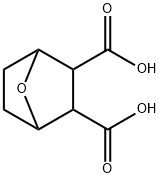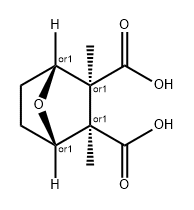ENDOTHAL
Synonym(s):7-Oxabicyclo[2.2.1]heptane-2,3-dicarboxylic Acid;Endothall - CAS 145-73-3 - Calbiochem
- CAS NO.:145-73-3
- Empirical Formula: C8H10O5
- Molecular Weight: 186.16
- MDL number: MFCD00137362
- EINECS: 205-660-5
- SAFETY DATA SHEET (SDS)
- Update Date: 2024-11-19 23:02:33

What is ENDOTHAL?
Chemical properties
Endothall, when pure, is a white crystalline solid. The technical grade is a light brown liquid
The Uses of ENDOTHAL
Endothall is used as an inhibitor of PP2A phosphatase activity. It is also used as a defoliant. It is used as a cell adhesion inhibitor.
The Uses of ENDOTHAL
Defoliant, herbicide.
The Uses of ENDOTHAL
Preemergence and postemergence herbicide for control of broad-leaved weeds and annual grass in vegetable crops. The disodium and dipotassium salts are used as defoliants and herbicides.
What are the applications of Application
Endothall is an herbicidal inhibitor of PP2A phosphatase activity
General Description
The monohydrate is in the form of colorless crystals. Non corrosive. Used as a selective herbicide.
Air & Water Reactions
Stable up to 90°C, above which ENDOTHAL undergoes slow hydrolysis.
Reactivity Profile
A phthalic acid derivative.
Hazard
Strong irritant to eyes and skin.
Agricultural Uses
Herbicide, Algaecide: Endothall is used as a cotton defoliant and as a selective contact herbicide on both terrestrial and aquatic weeds. The potassium and amine salts of endothall are used as aquatic herbicides to control a variety of plants including plankton, pondweed, niad, coontail, milfoil, elodea, and algaes in water bodies and rice fields. Endothall is also used to control annual grass and broadleaf weeds in sugar beets, spinach and turf. It reduces sucker branch growth in hops. Endothall is a desiccant to aid the harvest of alfalfa, potatoes, clover, and cotton. Not approved for use in EU countries. Approved for use in the U.S. and other countries. There are 24 global suppliers.
Trade name
ACCELERATE®; AQUATHOL®; DES-I-CATE®; HYDOUT®; HYDROTHAL-47®; HYDROTHOL®; NIAGARATHOL®; RIPENTHOL®; TRI-ENDOTHAL®
Safety Profile
Poison by ingestion. Very irritating to skin, eyes, and mucous membranes. Causes dlarrhea. When heatedto decomposition it emits acrid smoke and fumes
Potential Exposure
Endothall is dicarboxylic acid defoliant and herbicide used on both terrestrial and aquatic weeds.
First aid
If this chemical gets into the eyes, remove anycontact lenses at once and irrigate immediately for at least
Environmental Fate
Biological. Incubation of 14C-ring labeled endothall (10 mg/mL) by Arthrobacter sp.,
which was isolated from pond water and a hydrosol, in aerobic sediment-water suspensions
revealed that after 30 days, 40% evolved as 14CO2. Glutamic acid was the major transformation
product. Minor products were alanine, citric and aspartic acids and unidentified
products, some of which were tentatively identified as phosphate esters (Sikka and Saxena,
1973). In pond water treated with endothall (2 and 4 ppm), detectable levels were found
after 7 days (Sikka and Rice, 1973). Biodegradation was rapid in an Ontario soil sample.
After 1 week, 70% of endothall added was converted to carbon dioxide (Simsiman et al.,
1976).
Chemical/Physical. Reacts with bases forming water-soluble salts. Above 90°C, endothall
is slowly converted to the anhydride (Windholz et al., 1983; Hartley and Kidd, 1987)
and water (Humburg et al., 1989). Endothall is stable to light (Hartley and Kidd, 1987).
Shipping
UN2811 Toxic solids, organic, n.o.s., Hazard Class: 6.1; Labels: 6.1-Poisonous materials, Technical Name Required. UN2588 Pesticides, solid, toxic, Hazard Class: 6.1; Labels: 6.1-Poisonous materials, Technical Name Required.
Incompatibilities
Compounds of the carboxyl group react with all bases, both inorganic and organic (i.e., amines) releasing substantial heat, water and a salt that may be harmful. Incompatible with arsenic compounds (releases hydrogen cyanide gas), diazo compounds, dithiocarbamates, isocyanates, mercaptans, nitrides, and sulfides (releasing heat, toxic, and possibly flammable gases), thiosulfates and dithionites (releasing hydrogen sulfate and oxides of sulfur)
Waste Disposal
Small quantities may be disposed of by burial in soil which is rich in organic matter. Large quantities are best disposed of by incineration. Consult with environmental regulatory agencies for guidance on acceptable disposal practices. Generators of waste containing this contaminant (5100 kg/mo) must conform with EPA regulations governing storage, transportation, treatment, and waste disposal. In accordance with 40CFR165, follow recommendations for the disposal of pesticides and pesticide containers. Must be disposed properly by following package label directions or by contacting your local or federal environmental control agency, or by contacting your regional EPA office
Properties of ENDOTHAL
| Melting point: | 179-180℃ |
| Boiling point: | 447.8±40.0 °C(Predicted) |
| Density | 1.431 g/cm3 |
| storage temp. | +2C to +8C |
| solubility | DMF: 15 mg/ml,DMSO: 15 mg/ml,Ethanol: 15 mg/ml,PBS (pH 7.2): 0.2 mg/ml |
| pka | 3.62±0.40(Predicted) |
| form | White solid |
| color | White to off-white |
| Water Solubility | Soluble in water (>25 mg/ml), methanol, acetone, and DMSO. Insoluble in benzene. |
| Stability: | Hygroscopic |
| CAS DataBase Reference | 145-73-3(CAS DataBase Reference) |
| EPA Substance Registry System | Endothall (145-73-3) |
Safety information for ENDOTHAL
| Signal word | Warning |
| Pictogram(s) |
 Skull and Crossbones Acute Toxicity GHS06 |
| GHS Hazard Statements |
H301:Acute toxicity,oral H312:Acute toxicity,dermal H315:Skin corrosion/irritation H319:Serious eye damage/eye irritation H335:Specific target organ toxicity, single exposure;Respiratory tract irritation |
| Precautionary Statement Codes |
P261:Avoid breathing dust/fume/gas/mist/vapours/spray. P280:Wear protective gloves/protective clothing/eye protection/face protection. P305+P351+P338:IF IN EYES: Rinse cautiously with water for several minutes. Remove contact lenses, if present and easy to do. Continuerinsing. P405:Store locked up. |
Computed Descriptors for ENDOTHAL
New Products
4-AMINO-TETRAHYDRO-PYRAN-4-CARBOXYLIC ACID HCL 4-(Dimethylamino)tetrahydro-2H-pyran-4-carbonitrile 4-Aminotetrahydropyran-4-carbonitrile Hydrochloride (R)-3-Aminobutanenitrile Hydrochloride 3-((Dimethylamino)methyl)-5-methylhexan-2-one oxalate 1,4-Dioxa-8-azaspiro[4.5]decane 5-Bromo-2-nitropyridine Nimesulide BP Aceclofenac IP/BP/EP Diclofenac Sodium IP/BP/EP/USP Mefenamic Acid IP/BP/EP/USP Ornidazole IP Diclofenac Potassium THOMAIND PAPER PH 2.0 TO 4.5 1 BOX BUFFER CAPSULE PH 9.2 - 10 CAP SODIUM CHLORIDE 0.1N CVS ALLOXAN MONOHYDRATE 98% PLATINUM 0.5% ON 3 MM ALUMINA PELLETS (TYPE 73) LITHIUM AAS SOLUTION 2-Bromo-1-(bromomethyl)-3-chloro-5-nitrobenzene 2-Bromo-3-nitroaniline N-(3-Hydroxypropyl)-N-methylacetamide 3-Bromo-6-chloropyridazine 4-ethyl-3-nitrobenzoic acidRelated products of tetrahydrofuran





![DIMETHYL ENDOTHAL 10MG [R]](https://img.chemicalbook.in/)


You may like
-
 1-Methyl-6-oxo-1,6-dihydropyridazine-3-carbonitrile 98%View Details
1-Methyl-6-oxo-1,6-dihydropyridazine-3-carbonitrile 98%View Details
99903-60-3 -
 88491-46-7 98%View Details
88491-46-7 98%View Details
88491-46-7 -
 1823368-42-8 98%View Details
1823368-42-8 98%View Details
1823368-42-8 -
 2-(3-(tert-butyl)phenoxy)-2-methylpropanoic acid 1307449-08-6 98%View Details
2-(3-(tert-butyl)phenoxy)-2-methylpropanoic acid 1307449-08-6 98%View Details
1307449-08-6 -
 Ethyl 3-(furan-2-yl)-3-hydroxypropanoate 25408-95-1 98%View Details
Ethyl 3-(furan-2-yl)-3-hydroxypropanoate 25408-95-1 98%View Details
25408-95-1 -
 2-Chloro-5-fluoro-1-methoxy-3-methylbenzene 98%View Details
2-Chloro-5-fluoro-1-methoxy-3-methylbenzene 98%View Details
1805639-70-6 -
 1784294-80-9 98%View Details
1784294-80-9 98%View Details
1784294-80-9 -
 Lithium ClavulanateView Details
Lithium ClavulanateView Details
61177-44-4